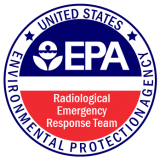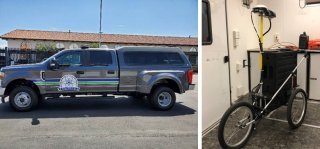Radiological Emergency Response: Expertise and Equipment
Report an Incident
To report a radiological emergency, please contact the interagency National Response Center at 1-800-424-8802.
To request specific EPA radiological support, please contact EPA's Emergency Operations Center at (202) 564-3850.
EPA's Radiological Emergency Response Team (RERT) is comprised of experts and specialized equipment used when responding to radiological emergencies.
Radiological Emergency Response Team (RERT)
EPA has on-scene coordinators and several special teams that focus on responding to environmental emergencies, including the Radiological Emergency Response Team (RERT). The RERT provides specialized support for radiological or nuclear emergency responses.

The RERT is a multidisciplinary team of scientists, engineers, health physicists (radiation experts), communications experts and laboratory staff, who support federal, state, local and tribal response efforts during all stages of a radiological response. The RERT is staffed by personnel from EPA’s National Center for Radiation Field Operations (Las Vegas), National Analytical Radiation Environmental Laboratory (Montgomery, Ala.), and the Radiation Protection Division (Washington, DC).
The RERT works closely with several EPA programs to support other federal, state, local, tribal, and territorial government response to a radiological/nuclear incident. RERT support includes:
- Technical advice and assistance to prevent or minimize threats to public health and the environment.
- Advice on protective action to ensure public health and safety.
- Assessment of public health effects from radiation exposure.
- Monitoring, sampling, laboratory analysis, assessment, and interpretation to evaluate and characterize environmental impacts.
- Data collection support to record, aggregate, and share sampling and/or monitoring results.
- Interpreting environmental fate and transport modeling.
- Public information assistance.
- Technical advice and planning for environmental containment, cleanup, restoration, and recovery following a radiological incident.
Equipment and Technical Services
The RERT offers the following types of equipment and services when responding to an incident:
- Field monitoring and sampling equipment, including alpha, beta, gamma, and neutron detection instruments; air sampling equipment; exposure rate and dose rate instruments; and field gamma spectroscopy.
- Radioanalytical laboratory services.
- Data assessment and interpretation.
- Satellite and internet-based communication capabilities.
Specialized Radiological Monitoring Equipment
The RERT can deploy several types of specialized radiological monitoring, sampling, and analysis equipment for radiological emergency response. EPA's radiological monitoring equipment includes:

Air Monitoring Support from RadNet
The RERT can provide expertise in use of RadNet, EPA’s nationwide monitoring system.
Mobile Command Post
The RERT’s Mobile Command Post:

- Provides responders, scientists, and other personnel with a flexible enclosed environment from which to direct field activities.
- Includes a command center, meeting room, and breakout area.
- Is equipped with a communication center to monitor response activities.
- Can be self-powered if needed.
Mobile Scanning
RERT can provide the following mobile scanning capabilities.

- A vehicle-based rapid scanning system designed to locate and identify gamma radiation sources in urban and remote environments and quickly map large areas for hotspots.
- A portable, mobile scanning system designed to identify gamma radiation sources in areas inaccessible to a vehicle.
Field Monitoring and Sample Collection Equipment
RERT’s field monitoring and sample collection equipment includes:

- Handheld field monitoring equipment to detect alpha, beta, gamma, and neutron radiation.
- High resolution in-situ gamma-ray spectrometer.
- Environmental sampling equipment (e.g., air, water, soil, vegetation).
Fixed Laboratory Radioanalytical Capabilities
The National Analytical Radiation Environmental Laboratory’s radioanalytical capabilities include:
- Analysis of multiple matrices
- Solid matrices: soil, sediment, vegetation, various building materials, etc.
- Liquid matrices: groundwater, rainwater, wastewater, drinking water, fracking liquids, etc.
- Air filters in various sizes.
- Radiochemical analyses
- Actinides -americium, plutonium, thorium, uranium in all matrices.
- Gross alpha/beta, strontium-89/90, tritium, and iodine-131 in water only.
- Gamma in all matrices.
- Radium-226 in all matrices.
- Radium-228 by gamma in all matrices.
- Instrumentation
- Alpha spectrometry detectors.
- Gamma detectors.
- Gas proportional counters (GPC).
- Liquid scintillation counters (LSC).
Additional EPA Radiation Response Assets

The RERT is one of several EPA emergency response teams. During a radiological emergency, EPA’s response may include regional radiation experts, on-scene coordinators, the Environmental Response Team (ERT) and the Chemical, Biological, Radiological, and Nuclear Consequence Management Advisory Division (CBRN CMAD).
The Airborne Spectral Photometric Environmental Collection Technology (ASPECT) plane is maintained and supported by CBRN CMAD and can be used to provide aerial radiation monitoring.
